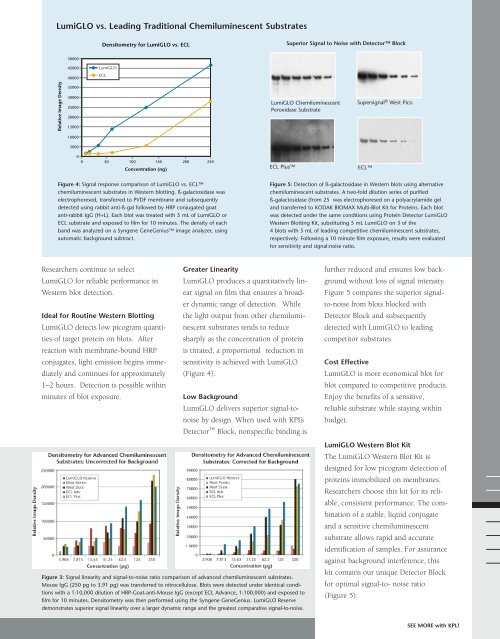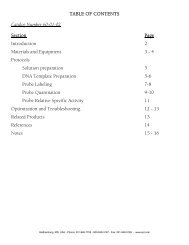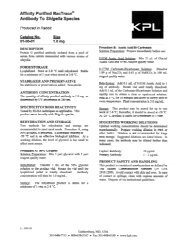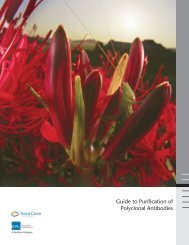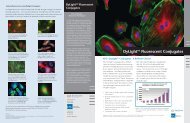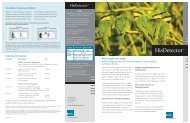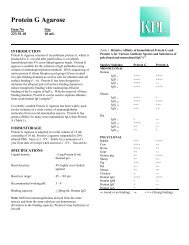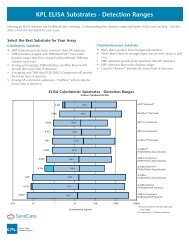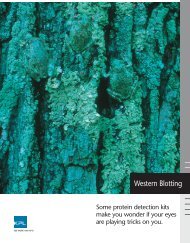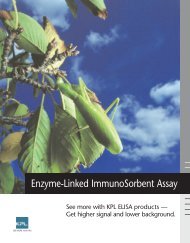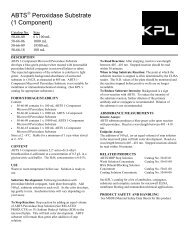Western Blotting - KPL
Western Blotting - KPL
Western Blotting - KPL
Create successful ePaper yourself
Turn your PDF publications into a flip-book with our unique Google optimized e-Paper software.
LumiGLO vs. Leading Traditional Chemiluminescent Substrates<br />
Densitometry for LumiGLO vs. ECL<br />
Superior Signal to Noise with Detector Block<br />
50000<br />
45000<br />
40000<br />
LumiGLO<br />
ECL<br />
Relative Image Density<br />
35000<br />
30000<br />
25000<br />
20000<br />
15000<br />
LumiGLO Chemiluminescent<br />
Peroxidase Substrate<br />
Supersignal ® West Pico<br />
10000<br />
5000<br />
0<br />
0 50 100 150 200 250<br />
Concentration (ng)<br />
ECL Plus<br />
ECL<br />
Figure 4: Signal response comparison of LumiGLO vs. ECL<br />
chemiluminescent substrates in <strong>Western</strong> blotting. ß-galactosidase was<br />
electrophoresed, transferred to PVDF membrane and subsequently<br />
detected using rabbit anti-ß-gal followed by HRP conjugated goat<br />
anti-rabbit IgG (H+L). Each blot was treated with 5 mL of LumiGLO or<br />
ECL substrate and exposed to film for 10 minutes. The density of each<br />
band was analyzed on a Syngene GeneGenius image analyzer, using<br />
automatic background subtract.<br />
Figure 5: Detection of ß-galactosidase in <strong>Western</strong> blots using alternative<br />
chemiluminescent substrates. A two-fold dilution series of purified<br />
ß-galactosidase (from 25 was electrophoresed on a polyacrylamide gel<br />
and transferred to KODAK BIOMAX Multi-Blot Kit for Proteins. Each blot<br />
was detected under the same conditions using Protein Detector LumiGLO<br />
<strong>Western</strong> <strong>Blotting</strong> Kit, substituting 5 mL LumiGLO on 3 of the<br />
4 blots with 5 mL of leading competitive chemiluminescent substrates,<br />
respectively. Following a 10 minute film exposure, results were evaluated<br />
for sensitivity and signal:noise ratio.<br />
Researchers continue to select<br />
LumiGLO for reliable performance in<br />
<strong>Western</strong> blot detection.<br />
Ideal for Routine <strong>Western</strong> <strong>Blotting</strong><br />
LumiGLO detects low picogram quantities<br />
of target protein on blots. After<br />
reaction with membrane-bound HRP<br />
conjugates, light emission begins immediately<br />
and continues for approximately<br />
1–2 hours. Detection is possible within<br />
minutes of blot exposure.<br />
Greater Linearity<br />
LumiGLO produces a quantitatively linear<br />
signal on film that ensures a broader<br />
dynamic range of detection. While<br />
the light output from other chemiluminescent<br />
substrates tends to reduce<br />
sharply as the concentration of protein<br />
is titrated, a proportional reduction in<br />
sensitivity is achieved with LumiGLO<br />
(Figure 4).<br />
Low Background<br />
LumiGLO delivers superior signal-tonoise<br />
by design. When used with <strong>KPL</strong>’s<br />
Detector Block, nonspecific binding is<br />
further reduced and ensures low background<br />
without loss of signal intensity.<br />
Figure 5 compares the superior signalto-noise<br />
from blots blocked with<br />
Detector Block and subsequently<br />
detected with LumiGLO to leading<br />
competitor substrates.<br />
Cost Effective<br />
LumiGLO is more economical blot for<br />
blot compared to competitive products.<br />
Enjoy the benefits of a sensitive,<br />
reliable substrate while staying within<br />
budget.<br />
Figure 3: Signal linearity and signal-to-noise ratio comparison of advanced chemiluminescent substrates.<br />
Mouse IgG (250 pg to 3.91 pg) was transferred to nitrocellulose. Blots were detected under identical conditions<br />
with a 1:10,000 dilution of HRP-Goat-anti-Mouse IgG (except ECL Advance, 1:100,000) and exposed to<br />
film for 10 minutes. Densitometry was then performed using the Syngene GeneGenius. LumiGLO Reserve<br />
demonstrates superior signal linearity over a larger dynamic range and the greatest comparative signal-to-noise.<br />
LumiGLO <strong>Western</strong> Blot Kit<br />
The LumiGLO <strong>Western</strong> Blot Kit is<br />
designed for low picogram detection of<br />
proteins immobilized on membranes.<br />
Researchers choose this kit for its reliable,<br />
consistent performance. The combination<br />
of a stable, liquid conjugate<br />
and a sensitive chemiluminescent<br />
substrate allows rapid and accurate<br />
identification of samples. For assurance<br />
against background interference, this<br />
kit contains our unique Detector Block<br />
for optimal signal-to- noise ratio<br />
(Figure 5).<br />
SEE MORE with <strong>KPL</strong>!


